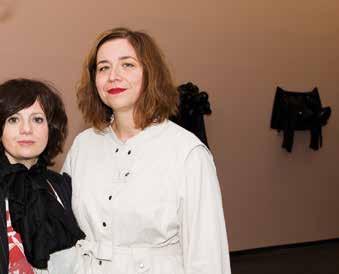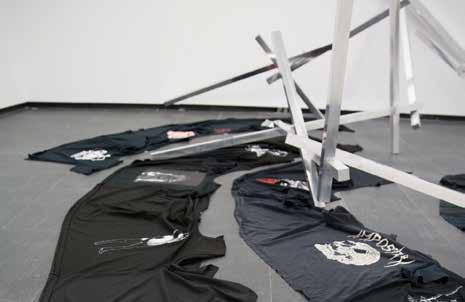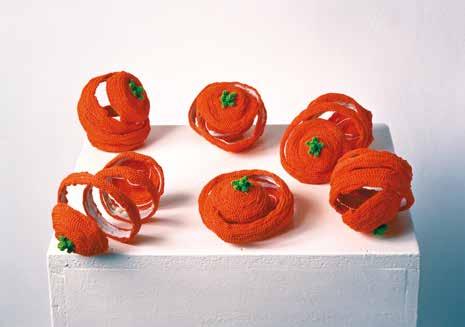
7 minute read
The day-to-day dimension through the eyes of Ana Laura Aláez
Ana Laura Aláez (Bilbao, 1964) defines herself as an 'architect of emotions' someone who transforms her experience into sculpture -even when using media that, apparently, are not necessarily artistic-, and uses sculpture as a transformation means. She claims that beauty is not found in standardization, but in difference, and asserts that art is an exercise of survival where the signs of everyday life are reread and put in favour of a more livable reality. Starting on May 20, we present in the Todos los conciertos, todas las noches, todo vacío exhibition, curated by Bea Espejo and co-produced with Centro de Arte Dos de Mayo, CA2M. The exhibition shows the work of the artist over the last three decades and expands the study of her production, as one of the most outstanding creations in the contemporary art scene. Ana Laura Aláez is a creator formed in the particularly conflictive Basque context of the 1980s, marked by the social and economic crisis, the resurgence of violence and the absence of expectations, as well as by a particular invisibility of women in most areas, especially, the culture scene. In these circumstances, the artist has developed –through a production that combines everyday elements with others that are inherently sculptural– a critique of representation that questions the rigid stereotypes imposed by the condition of class, gender and place.

Advertisement
THE ARTIST ADDS TO THE EXHIBITION AT AZKUNA ZENTROA MORE UNPUBLISHED PIECES THAN IN THE FIRST VENUE, ALSO CREATING A DOCUMENTATION AREA THAT INTENDS TO UNVEIL PART OF HER CREATIVE PROCESSES.

Todos los conciertos, todas las noches, todo vacío walks through Ana Laura Aláez's production bringing together some of the artist's latest work along with others from the beginning of her career. The exhibition, divided into four thematic groups –Abject objects and extensions; Excitement and emptiness; Violence and vulnerability; Myth, woman's sexuality, camouflage ideology– poses a dialogue between the different works, moving away from the concept of retrospective. Each space presents a main piece, surrounded by several groups of works, eluding a reading in linear time and trying to link each work with the rest, so that those fragmentary forms form a new whole. Rather than an exercise of ratification in each of the decisions that were taken at the time, we find ourselves before a new instrument that makes them appear under a new perspective. The exhibition’s namesake is another piece made by the artist in 2009, which becomes a key element in the exhibition. Although in times of pandemic the title of the exhibition inevitably acquires a more literal meaning, it evokes the trace of a post-event. It recalls the uninhabited spaces, as when the lights are turned on in an electronic music club and that location that seemed extraordinary is diluted. The past and the present. Illusions and expectations versus realizations and disappointments. As the curator describes, «due to its nature, this work multiplies different layers of reading and creates a degree of complexity that fits very well with the artist's creative tone. It works like a silence that generates an immense noise. It appeared after a moment of inflection in Aláez's work, in which she renewed her gaze, returning to the origin of her production and to the idea of using experience as an instrument that always adds value.»
After passing through Centro de Arte Dos de Mayo of the Community of Madrid, the artist adds a dozen totally unknown pieces to the Azkuna Zentroa exhibition: reinterpretations of iconic sculptures and two new ones. These include pieces that the artist has made from the nineties to the present, such as La cortesana (1992-2021), Pulseras (1993- 2014), Piel de naranja (1995-2021), Metal Lipsticks (1999-2021), Wonder Woman P.A (1993), No hables con extraños (1989), Braintree P.A (2008), Impostura (2014), Uñas rojas (revisited) (1991-2021) or Loba (2014). Some are works from her beginnings, where she focused more on sculpture. In her sculptural objects all kinds of elements are present, almost always of personal use, to which she incorporates, on numerous

occasions, a sexual charge and certain doses of humor and irony. This line of work can be seen in pieces such as La cortesana (1992-2021), made up of shoes, chains, and wigs. The materials and processes she uses are also diverse, such as crochet in Wonder Woman P.A. (1993), mending in Piel de Naranja (1995-2021) or latex in Pantalón Preservativo (1992-2021).
Ana Laura Aláez and the search for the infinite possible 'egos'
Ana Laura Aláez is one of the most relevant artists of the country's art scene. Her career and contributions were awarded by the Basque Government with the Gure Artea 2013 prize. Aláez's first public appearance was in Superficie, 1992, in Espacio 13 of the Joan Miró Foundation in Barcelona. This exhibition included the piece that would serve as a stepping stone to her international recognition: Mujeres sobre zapatos de plataforma. Made in New York, this work explores new sculptural concepts based on a deliberate vital attitude towards her practice that will mark her entire career: a search for the infinite possible 'egos'; a way of producing work without a studio and without means; or the insufficient presence of women in art. She Astronauts, 1997, exhibited at Sala Montcada in Barcelona, was the first installation she made, where the idea of the author was diluted with the participation of other artists. From then onwards, her work was classified within the «relational art» current.
In 2000, Aláez presented Dance & Disco, in Espacio 1 of MNCARS in Madrid, an autonomous nightclub within the museum that aroused great philias and phobias in the Spanish art scene. With the Peruvian duo Silvania, she published a CD under the name Girls on Film with compilations of the music expressly made for many of the videos that she had produced up to that moment. Since 2004 she collaborates with the German musician Ascii.disko. In 2001, in the Spanish Pavilion of 49th Venice Biennale, she showed three installations that were already suggesting her need to return to her origins. This desire would materialize much later, in 2008, and in a more resounding way with Pabellón de Escultura, MUSAC, León. In that same year
she created a permanent piece, Bridge of Light, for the Towada Art Center, Japan. That spirit of negotiating and reconciling with the non-linear processes that an artist lives throughout her life could be seen in Impostura (2014), at the Moisés Pérez de Albéniz gallery in Madrid. In 2015 her activity in Kalostra, San Sebastián, an experimental pedagogical project taught by and for artists, stands out. In 2018 she held her second solo exhibition, Resistencia en Bilbao, her hometown, at the Carreras Múgica gallery. Among some of her exhibitions in museums, the following stand out: The Real Royal Trip (2003. PS1, MOMA. N.Y); Hell Disco (2004. Helsinki City Art Museum, Helsinki; y Centro Cultural de España, México); Signale Der Kleidung (2004. Podewil Center of Contemporary Art, Berlín); Goodbye Horses-Kiss the Frog. The Art of Transformation (2005. The National Museum of Art, Architecture and Design, Oslo); Arquitectura de Sonido (2006. Museo Banco de la República de Bogotá); Incógnitas. Cartografías del Arte Contemporáneo en Euskadi (2007. Guggengeim Museum, Bilbao) Now, the artist returns to her origins, as Bea Espejo explains, «to search among the fissures of the themes that have accompanied her work in the last thirty years: the body as a plinth, the plinth as a sculpture, the sculpture as a song, the night as material, identity as conflict, skin as a suit, imposition as possibility. A porous dialogue based on repetition that affects the incompleteness of structure and the power of resonances.»
ANA LAURA ALÁEZ TODOS LOS
CONCIERTOS TODAS LAS NOCHES TODO VACÍO
Exhibition image
Koprodukzioa Coproducción Coproduction Name of the exhibition: Ana Laura Aláez. Todos los conciertos, todas las noches, todo vacío Curator: Bea Espejo Dates: From May 20 to September 26, 2021 Opening: May 20, Thursday Public programme: • Guided visits Every Thursday at 6:00 p.m. and 7:00 p.m. • Meeting: Ana Laura Aláez and Bea Espejo with Alicia San Juan May 19, Wednesday. 6:30 p.m. Auditorium. Free admission prior register on azkunazentroa.eus until full capacity is reached Resources: Online audio guide service Publications: Catalogue of the exhibition: Todos los conciertos, todas las noches, todo vacío. It includes fundamental 2021(E)KO MAIATZAREN 20(E)TIK 2021(E)KO IRAILAREN 26(E)RAtexts that frame the artist’s work, made by: Bea Espejo, DEL 20 DE MAYO DE 2021 AL 26 DE SEPTIEMBRE DE 2021 FROM MAY 20, 2021 TO SEPTEMBER 26, 2021Ángel Bados, Paul B. Preciado, María José Belver, Sonia Fernández Plan and Ana Laura Aláez. You can buy the catalogue at dendAZ, the Azkuna Zentroa’s shop and at dendaz.azkunazentroa.eus







